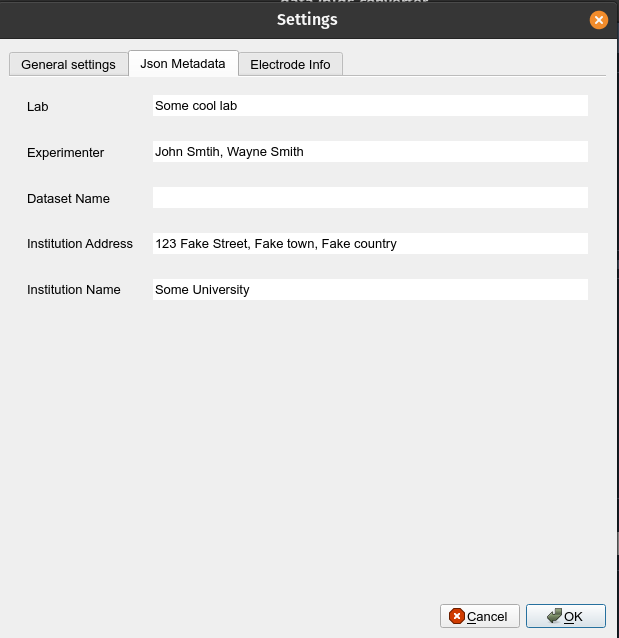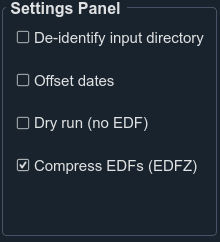Edit this page
Open an issue
data2bids Settings
Adjusting metadata settings¶
Note
You will only need to modify these settings once upon initial installation of the data2bids software
-
In the data2bids software, select File then Settings.

-
A settings panel will appear with two tabs: Json Metadata and Electrode Info.
- Json metadata contains general information about the dataset.
- Lab: what is the name of the lab collecting this data
- Experimenter: list all individuals involved in this dataset
- Dataset Name: overall name for the dataset.
- Institution Name/Address: name and address of the institution at which this dataset was collected

- Electrode info contains information about the specific electrodes used at the center:
- Manufacturer: who produces the electrodes.
- Type: what type of electrode is it (i.e. depth, scalp etc.)
- Material: what material are the electrodes made from (i.e. platinum)
- Diameter: what is the diameter of the electrode (in mm)

- Json metadata contains general information about the dataset.
-
Once you have modified the information click Save and the information will be stored and used for every subsequent dataset processed by data2bids. You will not need to re-define these values, unless they change at your site.
Main window settings panel¶
-
The settings panel is located at the bottom left of the main window.

- De-identify input directory: if this is selected the input EDF/EDF+ files will be de-identified first prior to being copied. If left unchecked, then only the output directory EDF/EDF+ files will be de-identified. Default is unchecked.
- Offset dates: if selected all dates in the EDF/EDF+ files will be offset by a random number of days (~1000 days). The offset value can be determined but is securely stored.
- Dry run: this should be selected when running a new conversion. This option will not copy the EDF/EDF+ files to the output directory but will check to ensure the input directory is set-up correctly. Since copying the EDF/EDF+ files is a time-intensive process, this dry-run will be much faster then a full conversion and will notify you if any files are formated incorrectly within the input directory.
- Compress EDFs (EDFZ): if selected the EDF+ output files will be further compressed using GZIP (with final extension
.edfz). For more information, see the documentation from Dr. Shaun Purcell's lab at Harvard.